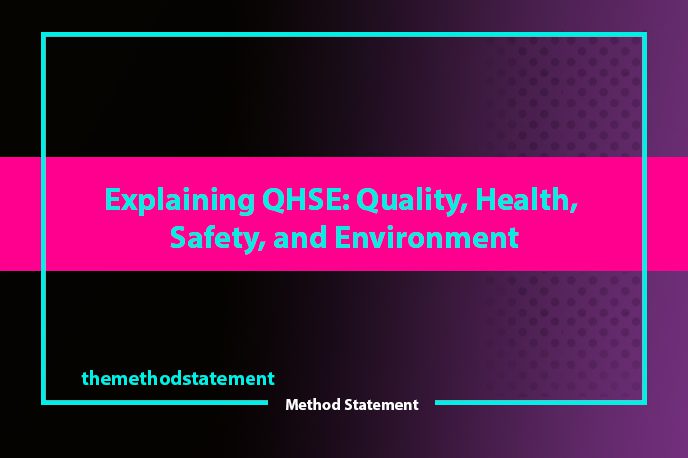Table of Contents
What is QHSE?
QHSE, an abbreviation for Quality, Health, Safety, and Environment, is a widely used term worldwide. Sometimes the term ‘environment’ is replaced by ‘environmental.’ These four components combine to form an integrated corporate management approach. According to this approach, all workplace accidents are caused by human error, and we can eliminate, reduce, isolate, and control these accidents by providing our employees with safety awareness, training, and good administration.
Risk assessment and management are integral parts of any HSE management system. Recently, sustainability has also been added to the mix, closely dealt with within the same domain. So, in a way, sustainability is also part of QHSE.
The QHSE Evolution
The evolution of QHSE can be considered a newly developed approach, thanks to revised QHSE management standards that are also based on an integrated approach and minimize documentation. In the early 21st century, it was understood that quality, health, and safety departments could be integrated and merged to minimize overall expenses and make QHSE management and monitoring more productive and result-oriented.
Considering the quality, health, safety, and environment as integrated components help companies promote quality, safe operations with zero injuries and illnesses, manage to reduce pollution and waste, and manage and minimize occupational illnesses and exposures.
Integrated QHSE management is widely used in organizations in standardized forms and according to international management standards like the quality management standard ISO 9001:2015, occupational safety OHSAS 18001:2007 standard, and environmental management standard ISO 14001:2015. Many companies implement QHSE to comply with these standards and receive certification after implementation.
A QHSE manager, engineer, coordinator, etc., is a highly specialized career that is in demand in high-risk industries like construction, oil and gas, and chemical plants, which require protecting employees from safety and health risks and the environment from being polluted by company activities. At the same time, the QHSE system ensures excellent service and customer satisfaction through quality management.
The Relationship between Method Statement and QHSE
Method statements and QHSE policies are closely related. A method statement outlines the specific steps and procedures required to complete a task safely and efficiently, while QHSE policies ensure that the task is carried out in a way that minimizes risks to health, safety, and the environment.
An effective method statement should include QHSE considerations, such as identifying potential hazards and risks associated with the task and outlining the control measures to mitigate them. The QHSE policy should provide guidance on how to develop a method statement that meets the company’s safety and environmental standards.
The Importance of Including QHSE in a Method Statement
Including QHSE considerations in a method statement is essential for ensuring that the task is carried out safely and with minimal impact on the environment. By identifying potential hazards and risks and outlining control measures to mitigate them, companies can minimize the risk of accidents and incidents.
Moreover, including QHSE considerations in a method statement can help to promote a culture of safety and responsibility among employees, contractors, and other stakeholders. It demonstrates the company’s commitment to protecting the health and safety of its workers and the environment.
Conclusion
In conclusion, QHSE, or QSHE, stands for an integrated approach to managing an organization’s management systems, focusing on Quality, Health, Safety, and Environment.
See Also: Toolbox Talk for Method Statement
FAQs
Why is QHSE important in the workplace?
QHSE is important in the workplace as it ensures that the workplace is safe and healthy for employees, while also promoting environmental sustainability. By implementing QHSE measures, organizations can minimize the risk of accidents and injuries, reduce environmental impact, and improve overall operational efficiency.
How can organizations implement effective QHSE programs?
Organizations can implement effective QHSE programs by identifying and assessing risks, developing policies and procedures to mitigate those risks, and regularly monitoring and evaluating the program to ensure its ongoing effectiveness. It is important to involve employees at all levels in the development and implementation of QHSE programs to ensure their commitment and participation.
What are some common QHSE hazards in the workplace?
Common QHSE hazards in the workplace include physical hazards such as slips, trips, and falls, chemical hazards such as exposure to harmful substances, biological hazards such as exposure to infectious diseases, and environmental hazards such as extreme temperatures and noise pollution
What are some benefits of implementing QHSE programs in the workplace?
Benefits of implementing QHSE programs in the workplace include reduced risk of accidents and injuries, improved employee health and well-being, reduced environmental impact, improved compliance with regulations, and enhanced organizational reputation and trust among stakeholders.
What is the role of leadership in promoting QHSE in the workplace?
Leadership plays a critical role in promoting QHSE in the workplace by setting the tone from the top, establishing a culture of safety and sustainability, and ensuring that resources are allocated to support QHSE initiatives. Leaders also need to communicate the importance of QHSE to employees and hold themselves and others accountable for QHSE performance.
tag: # QHSE: Quality, Health, Safety, and Environment
See Also: Health Safety Environment HSE Construction Site Establishment Procedure
